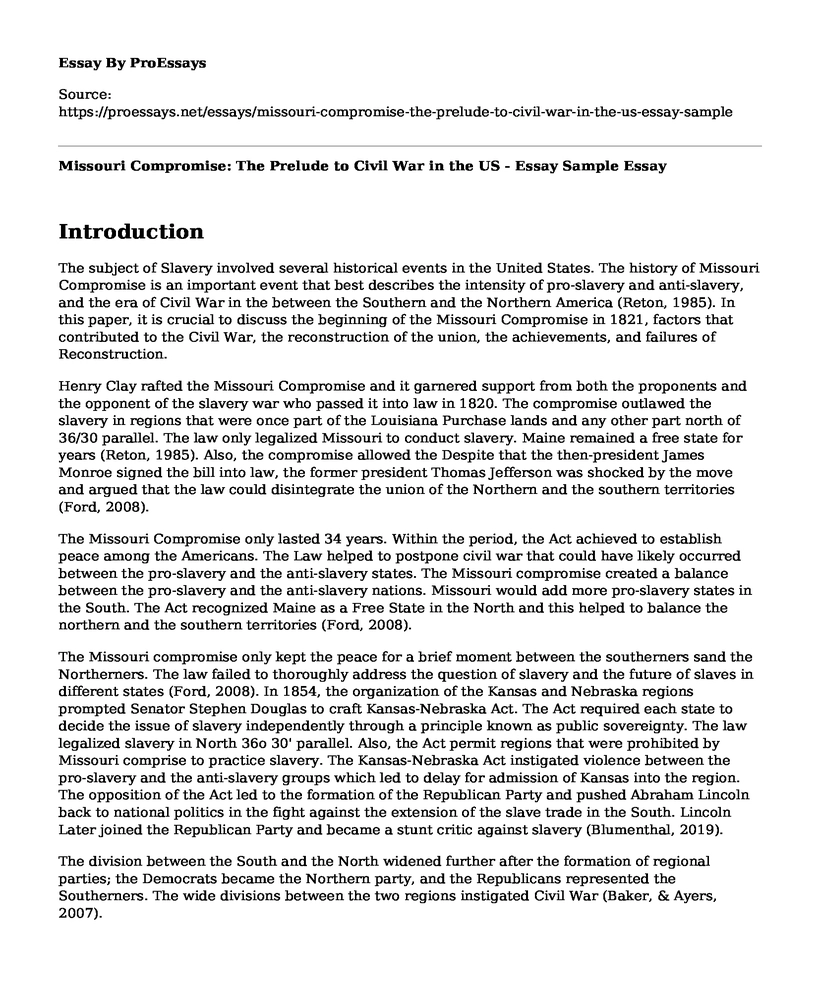Introduction
The subject of Slavery involved several historical events in the United States. The history of Missouri Compromise is an important event that best describes the intensity of pro-slavery and anti-slavery, and the era of Civil War in the between the Southern and the Northern America (Reton, 1985). In this paper, it is crucial to discuss the beginning of the Missouri Compromise in 1821, factors that contributed to the Civil War, the reconstruction of the union, the achievements, and failures of Reconstruction.
Henry Clay rafted the Missouri Compromise and it garnered support from both the proponents and the opponent of the slavery war who passed it into law in 1820. The compromise outlawed the slavery in regions that were once part of the Louisiana Purchase lands and any other part north of 36/30 parallel. The law only legalized Missouri to conduct slavery. Maine remained a free state for years (Reton, 1985). Also, the compromise allowed the Despite that the then-president James Monroe signed the bill into law, the former president Thomas Jefferson was shocked by the move and argued that the law could disintegrate the union of the Northern and the southern territories (Ford, 2008).
The Missouri Compromise only lasted 34 years. Within the period, the Act achieved to establish peace among the Americans. The Law helped to postpone civil war that could have likely occurred between the pro-slavery and the anti-slavery states. The Missouri compromise created a balance between the pro-slavery and the anti-slavery nations. Missouri would add more pro-slavery states in the South. The Act recognized Maine as a Free State in the North and this helped to balance the northern and the southern territories (Ford, 2008).
The Missouri compromise only kept the peace for a brief moment between the southerners sand the Northerners. The law failed to thoroughly address the question of slavery and the future of slaves in different states (Ford, 2008). In 1854, the organization of the Kansas and Nebraska regions prompted Senator Stephen Douglas to craft Kansas-Nebraska Act. The Act required each state to decide the issue of slavery independently through a principle known as public sovereignty. The law legalized slavery in North 36o 30' parallel. Also, the Act permit regions that were prohibited by Missouri comprise to practice slavery. The Kansas-Nebraska Act instigated violence between the pro-slavery and the anti-slavery groups which led to delay for admission of Kansas into the region. The opposition of the Act led to the formation of the Republican Party and pushed Abraham Lincoln back to national politics in the fight against the extension of the slave trade in the South. Lincoln Later joined the Republican Party and became a stunt critic against slavery (Blumenthal, 2019).
The division between the South and the North widened further after the formation of regional parties; the Democrats became the Northern party, and the Republicans represented the Southerners. The wide divisions between the two regions instigated Civil War (Baker, & Ayers, 2007).
The civil war caused massive devastation in the South. The war led to social disorder, loss of property and economic turmoil. The reconstruction process was initiated in 1866 and its objectives were to restore the unity of the North and the South, to rebuild the Southern region and to enact laws that favored the freedom of the slaves. The laws Congress enacted the 13th amendment which abolished slavery, the Civil Rights Acts of 1866, and the 14th Amendment which recognized the African America Citizenship. The Fifteenth Amendment empowered the black the right to vote, and the Civil Rights Act criminalized any form of racial prejudice (Astor, 2017).
The reconstruction era had several achievements and failures. It brought to an end the era of slavery in all the Southern States and it reunited the Northern and the Sothern states. However, the Reconstruction failed in several ways. The removal of troops that helped to restore sanity in South left, the slave-owners regained power and their legislatures enacted that were discriminative caused further suffering to the freed slaves (Ford, 2008).
Conclusion
To sum it up, Missouri Compromise contributed to the emergence of Civil War in the US. The rivalry between the anti-slavery and the proslavery resulted into political realignment and regional divisions between the North and the South. The reconstruction era was a win for the anti-slavery since it resulted in the abolishment of slavery.
References
Astor, A. (2017). Reconstruction Archives. Retrieved from https://www.journalofthecivilwarera.org/tag/reconstruction/
Baker, B. E., & Ayers, E. L. (2007). What reconstruction meant: Historical Memory in the American South. Charlottesville: University of Virginia Press.
Blumenthal, S. (2019). A Nation Headed to Civil War: The Compromise of 1850. Retrieved from https://historynewsnetwork.org/article/172969
Ford, L. (2008). The Missouri Compromise and Its Aftermath: Slavery and the Meaning of America. The American Historical Review, 113(4), 1160-1161. doi:10.1086/ahr.113.4.1160
Reton, J. (1985, October 23). Opinion | WASHINGTON; The Missouri Compromise. Retrieved from https://www.nytimes.com/1985/10/23/opinion/washington-the-missouri-compromise.html
Cite this page
Missouri Compromise: The Prelude to Civil War in the US - Essay Sample. (2023, Mar 20). Retrieved from https://proessays.net/essays/missouri-compromise-the-prelude-to-civil-war-in-the-us-essay-sample
If you are the original author of this essay and no longer wish to have it published on the ProEssays website, please click below to request its removal:
- California Between the Wars
- Bayeux Tapestry, Vikings, Krak Des Chevaliers, and Roman Empire Essay
- The Roman Empire Never Fell - Essay Sample
- Essay Example on Artists in War: Pictorial Records, Patriotism & Unity
- Essay Example on Stalin: From Peasantry to Soviet Supremacy
- Essay Example on Michael Faraday: 19th Century Chemist & Physicist
- The Grandeur of Ancient Rome: A Historical Overview - Essay Sample







